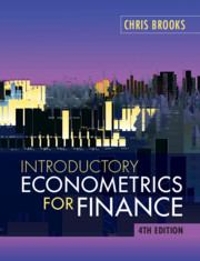Suppose that we have calculated the estimates for the intercept and the slope (1.10 and 19.88, respectively)
Question:
Suppose that we have calculated the estimates for the intercept and the slope (1.10 and –19.88, respectively) and their corresponding standard errors (1.35 and 1.98, respectively). The t-ratios associated with each of the intercept and slope coefficients would be given by Note that if a coefficient is negative, its t-ratio will also be negative.
In order to test (separately) the null hypotheses that α = 0 and β = 0, the test statistics would be compared with the appropriate critical value from a t-distribution. In this case, the number of degrees of freedom, given by T – k, is equal to 15 – 2 = 13.
The 5% critical value for this two-sided test (remember, 2.5% in each tail for a 5% test) is 2.16, while the 1% two-sided critical value (0.5% in each tail) is 3.01. Given these t-ratios and critical values, would the following null hypotheses be rejected?
If H0 is rejected, it would be said that the test statistic is significant. If the variable is not ‘significant’, it means that while the estimated value of the coefficient is not exactly zero (e.g. 1.10 in the example above), the coefficient is indistinguishable statistically from zero. If a zero were placed in the fitted equation instead of the estimated value, this would mean that whatever happened to the value of that explanatory variable, the dependent variable would be unaffected. This would then be taken to mean that the variable is not helping to explain variations in y, and that it could therefore be removed from the regression equation. For example, if the t-ratio associated with x had been –1.04 rather than –
10.04 (assuming that the standard error stayed the same), the variable would be classed as insignificant (i.e., not statistically different from zero). The only insignificant term in the above regression is the intercept. There are good statistical reasons for always retaining the constant, even if it is not significant; see Chapter 5.
It is worth noting that, for degrees of freedom greater than around 25, the 5% two-sided critical value is approximately ±2. So, as a rule of thumb (i.e., a rough guide), the null hypothesis would be rejected if the t-statistic exceeds 2 in absolute value.
Some authors place the t-ratios in parentheses below the corresponding coefficient estimates rather than the standard errors. One thus needs to check which convention is being used in each particular application, and also to state this clearly when presenting estimation results.
There will now follow two finance case studies that involve only the estimation of bivariate linear regression models and the construction and interpretation of t-ratios.
Step by Step Answer:






